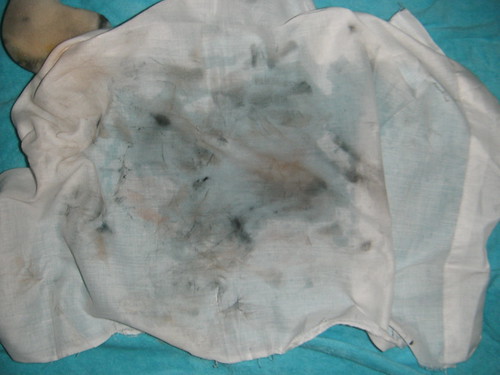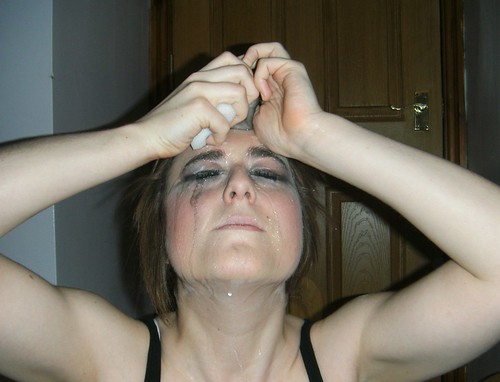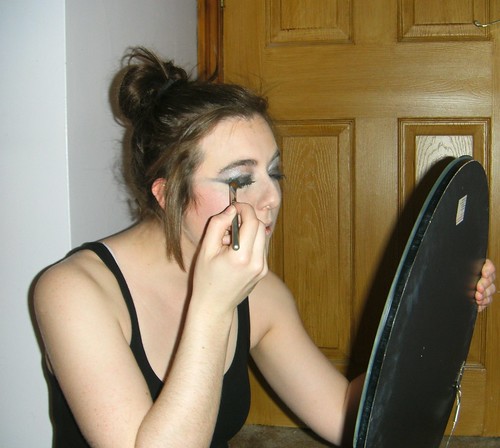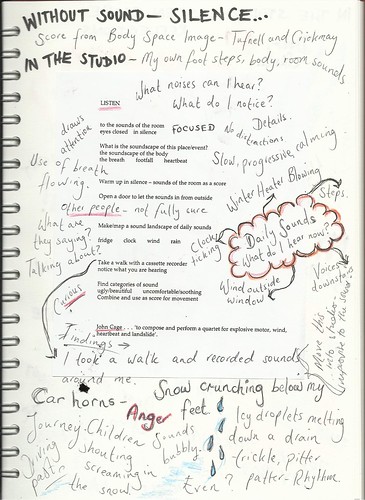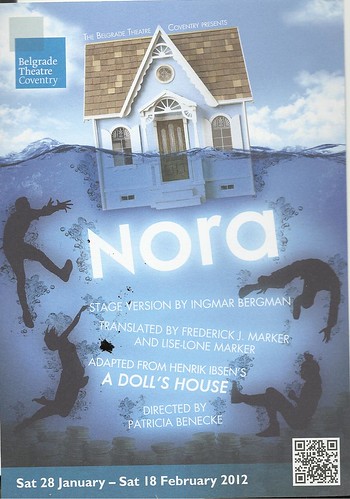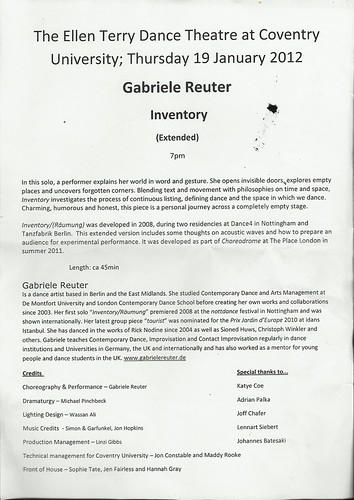
26 Feb 2012
IPP2 Piece Ideas
Experiences within this module have led me to explore the concept of leaving traces to reveal a piece of lasting art. Body Art –The Violated Body lecture introduced me to Franko B’s work and I have been researching and developing ideas of my own traces leaving a mark. I am interested in the Feminist ideas raised by the Guerrilla Girls and how they were masked and their real identities hidden while protesting. This idea of hidden identity is personal to me. I have noticed that I gain confidence by applying makeup and covering up ‘imperfections’. This has made me question what is perfection? Is everything a facade? How can we find the truth? I have been experimenting with the notion of stripping away and looking within. By using water, makeup, cloth, paints and sheets, I have been able to explore these issues in a way that leaves a lasting mark.
I propose to develop these concepts within studio spaces into a larger exploration. I will continue this process, free of the limitations of an end product.
I propose to develop these concepts within studio spaces into a larger exploration. I will continue this process, free of the limitations of an end product.
15 Feb 2012
Working without Sounds - taken from Body Space Image - score: Silence
Listen
to the sounds of the room
eyes closed in silence
What is the soundscape of this place/event?
the soundscape of the body
the breath footfall heartbeat
Warm up in silence - sounds of the room as a score
Open a door to let the sound in from outside
to the sounds of the room
eyes closed in silence
What is the soundscape of this place/event?
the soundscape of the body
the breath footfall heartbeat
Warm up in silence - sounds of the room as a score
Open a door to let the sound in from outside
Negotiated Study
SOUND
Silence
Found
Natural
Energy
Noise
Tone
Communication
Music
Vibrations
Sound Waves
Silence
Found
Natural
Energy
Noise
Tone
Communication
Music
Vibrations
Sound Waves
Negotiated Study
In my Negotiated Study I aim to explore how sound (found and natural, voice, silence and music) have an impact when creating movement and dance. I will not only look at the relationship between movement and sound and how it can be compatible and work together, but also how they can juxtapose to create contrasting clashes. I would like to look further into this area of my study by involving a live musician within explorations. I was interested when watching an interview by Deborah Hay when she raised the question ‘What is a performance without sound?’ I also aim to research into how sound can alter an audience’s view and experience of a piece of work.
Crossing Borders IPP Task
I listened to Lucy Cash’s Crossing Borders 06/11/09 talk. This talk began with the question ‘if an artist’s background is dance, but their work doesn’t come out through a movement form – do we call the work dance – or do we call it something else? Are we then dancers? Lucy Cash talks about how we can think of interdisciplinary performance work as an ‘applied craft’ and that we are ‘applied choreographers’.
I found it interesting to hear her background and about how events in her life have brought her to where she is today. Lucy cash trained in dance from a young age. She got hit by a car after a long morning of dance and dislocated her knee and fractured her skull – but didn’t break spine. She was then told she could no longer dance. After hearing this news she went to university to study performance and film. This exposed her to a range of theories and ideas. After graduating she worked as a performer and didn’t see herself as a maker. She began to leave behind this idea and began to make work herself.
She expresses how she is drawn to looking at the extraordinary appearance of ordinary things. When crossing art forms – words to think about: translation and displacement. Rather than being sought out, the sources will come to the artist. When collaborating, not all artists speak the same ‘language’. However, everyone has rhythmic intuition. As people we have an awareness of rhythm within life. The sequence of locking and unlocking a door is using rhythm in our everyday life. When an audience member sees a person fall on stage – the viewer falls too.
“Our body is in the world like the heart is in an animal”
“The purpose of art is to challenge perception”
“When we are silent and standing still, we are not resting, we’re searching inside ourselves for the turn”
I found it interesting to hear her background and about how events in her life have brought her to where she is today. Lucy cash trained in dance from a young age. She got hit by a car after a long morning of dance and dislocated her knee and fractured her skull – but didn’t break spine. She was then told she could no longer dance. After hearing this news she went to university to study performance and film. This exposed her to a range of theories and ideas. After graduating she worked as a performer and didn’t see herself as a maker. She began to leave behind this idea and began to make work herself.
She expresses how she is drawn to looking at the extraordinary appearance of ordinary things. When crossing art forms – words to think about: translation and displacement. Rather than being sought out, the sources will come to the artist. When collaborating, not all artists speak the same ‘language’. However, everyone has rhythmic intuition. As people we have an awareness of rhythm within life. The sequence of locking and unlocking a door is using rhythm in our everyday life. When an audience member sees a person fall on stage – the viewer falls too.
“Our body is in the world like the heart is in an animal”
“The purpose of art is to challenge perception”
“When we are silent and standing still, we are not resting, we’re searching inside ourselves for the turn”
Gaby Reuter - Inventory
Gabriele Reuter performed this extended piece at Coventry University (19/01/12). She is a well-known dance artist who works in Germany and also the East Midlands. In this piece Gabriele explores space, time, philosophies and her own existence within performance.
This solo invites the audience into this exploration at the same time as concealing elements that are personal to the performer. At first Gabriele defines the different spaces around her, identifying places for text and spoken word, political and critical thinking, props, obvious things and an area for her height. She also describes a large, soft, round area for dance and an accompanying one for music. Her movements are linked with words to describe her thoughts and ideas as she journeys across the empty space.
This work embraces the Post-modern celebration of everyday movement used within dance. She uses the style of pedestrian movement and explores the sounds that her body makes on the floor. Within her ‘Clipping Space’ section, Gabriele incorporates chopping arm movements with straight hands. Movement is juxtaposed with stillness as seen when she stands still saying ‘something is happening in the other side of the space, that doesn’t involve me’.
‘Inventory’ engages the audience with the idea that movement and expression is a valid dance form and anybody is a dancer. Doors only she can see are opened and defined spaces painted in the audiences mind. Some of these spaces are described as personal to the performer. For example, Gabriele tells us about a small box up high with a lock and golden key. She keeps her thoughts and ‘genius’ ideas hidden away within the box, and only lets them out occasionally. This example also reveals the humour within the piece, alongside vulnerability and honesty.
Time is explored in relation to space. She uses her body to convey the image of a clock, and states that she can show us time passing. A series of repetitive arm movements leads to the thought of what happened previously in this space. She questions ‘What was in this space?’, ‘What is above this space’ and ‘Where was I when I wasn’t in this space’?
This piece centres around Gabriele’s relaxed, natural performance style where she is at one with the audience. Within the work she says ‘the space between performer and audience is not empty, but we cannot see it, it is invisible’. This allows aspects of the performance to have no barriers at the same time as leaving some doors closed or slightly ajar.
This solo invites the audience into this exploration at the same time as concealing elements that are personal to the performer. At first Gabriele defines the different spaces around her, identifying places for text and spoken word, political and critical thinking, props, obvious things and an area for her height. She also describes a large, soft, round area for dance and an accompanying one for music. Her movements are linked with words to describe her thoughts and ideas as she journeys across the empty space.
This work embraces the Post-modern celebration of everyday movement used within dance. She uses the style of pedestrian movement and explores the sounds that her body makes on the floor. Within her ‘Clipping Space’ section, Gabriele incorporates chopping arm movements with straight hands. Movement is juxtaposed with stillness as seen when she stands still saying ‘something is happening in the other side of the space, that doesn’t involve me’.
‘Inventory’ engages the audience with the idea that movement and expression is a valid dance form and anybody is a dancer. Doors only she can see are opened and defined spaces painted in the audiences mind. Some of these spaces are described as personal to the performer. For example, Gabriele tells us about a small box up high with a lock and golden key. She keeps her thoughts and ‘genius’ ideas hidden away within the box, and only lets them out occasionally. This example also reveals the humour within the piece, alongside vulnerability and honesty.
Time is explored in relation to space. She uses her body to convey the image of a clock, and states that she can show us time passing. A series of repetitive arm movements leads to the thought of what happened previously in this space. She questions ‘What was in this space?’, ‘What is above this space’ and ‘Where was I when I wasn’t in this space’?
This piece centres around Gabriele’s relaxed, natural performance style where she is at one with the audience. Within the work she says ‘the space between performer and audience is not empty, but we cannot see it, it is invisible’. This allows aspects of the performance to have no barriers at the same time as leaving some doors closed or slightly ajar.
Studio Practice
What are my colours and textures? Constant change, breath, rotation, unexpected, levels, control... Surprises ... Trust I found that I could keep my eyes closed. I trusted the people around me and myself.
Subscribe to:
Posts (Atom)
